About us
Australian owned and operated since 1983.
- 100% Quality Guarantee On All Workmanship
- Multi-Award-Winning Timber Flooring Specialists
- 40+ Years of Industry Expertise
- 12-Month Warranty on All Work & Products
- Fully Licensed & Insured
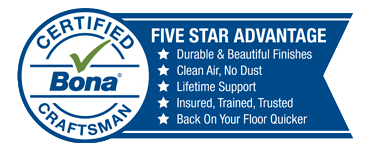

Get a Free Quote
EXCELLENTTrustindex verifies that the original source of the review is Google. I am so impressed with this team . So efficient quick friendly well priced. They came to quote to replace our old wooden floor boards gave us a reasonable price then came back a week or so later and completed the job very quickly. The new floor looks amazing. They came when they said they would and tidied up even taking away some of the stuff under the house and fixing a crooked piling. Totally recommend them !Trustindex verifies that the original source of the review is Google. David and his team are efficient and highly skilled, and a pleasure to be around. They have sanded and recoated our timber floors twice, and each time we are delighted with the results.Trustindex verifies that the original source of the review is Google. Excellent customer service and quality of workmanship! You can't go wrong with these guys!Trustindex verifies that the original source of the review is Google. AJ Flooring did a simply wonderful job restoring our deck to its original condition with the application of Cutek oil. Preparation was thorough and clean up was excellent with no spillage on white screen walls when fiddly detailed screens required detailed application. I’ll definitely be using them again. My extensive deck looks brand new. I can’t wait to enjoy it over summer.Trustindex verifies that the original source of the review is Google. Very professional and made everything so easy and accomodating for me. They completed a wonderful repair & refinish on my floor after I had unfortunately initially used another company which left me very unhappy and upset with the result. The end product was better than I could have hoped. David and his team are skilled tradesman who take pride in the result, which is rare these days! The team were very happy and jovial and it was a nice change from the serious & somewhat intimidating nature of other tradesman I’ve worked with in the past. A wonderful experience and I recommend them to all friends and family whom are looking in to flooring work.Trustindex verifies that the original source of the review is Google. I am super grateful for the amount of work Fiona and the team has put into our timber decks, many hours of hard work went into making sure my floors were absolutely perfect and matched my vision! Thank you A J Flooring for going above and beyond; definitely the best flooring contractors in Wahroonga!Trustindex verifies that the original source of the review is Google. From start to finish, the team displays an impressive level of expertise and dedication. The quality of their work is truly remarkable. A special mention to Fiona, who is the best face and point of contact anyone could ever deal with. She is incredibly knowledgeable, friendly, and responsive, making everything so easy and stress-free. Fiona’s dedication to customer satisfaction is evident, and she always goes the extra mile to ensure everything is perfect. If you're looking for a flooring company that combines great service with a high level of professionalism, AJ Flooring is the only option.Trustindex verifies that the original source of the review is Google. This is the third job they have done for us. This one was tricky being a 130 year old heritage house with original floorboards that have now been refurbished and look very original. A wonderful job and we have another for them in our adjacent areas.Trustindex verifies that the original source of the review is Google. AJ Flooring are the decent people to deal with. No tricks, no hassles, no niggle - just get in and get the job done. They worked with me to ensure that my household wasn't turned completely upside down during installation to. Highly recommended.Trustindex verifies that the original source of the review is Google. Dave and team restored our old pine floors and stained them to a beautiful colour. We had cracked timber, holes and gaps everywhere and all of these were repaired as part of the job.
Everything you need to know about Timber Flooring
Look no further than timber and hardwood flooring!
From its rustic charm to its durability and sustainability, timber and hardwood flooring have been a favourite choice for centuries.
Here we discuss everything from benefits to variation, maintenance, and design tips and ideas.
Let’s get started!
Get to know A J Flooring.
A J Flooring is owned and operated by David and Fiona Smith. David has been in the flooring industry since 1983. David comes armed with a wealth of knowledge and professionalism. A J Flooring is a multi-award winning Company.
Why Choose Timber Flooring?
We understand it can be hard sometimes to justify the price tag of timber floors, so let’s explore the reason as to why timber has been a popular choice for so long.
Timber and hardwood floors are a living and breathing product that is synonymous with sophistication and durability. Unlike other flooring materials, such as laminate or vinyl, they are crafted from natural wood. No two trees grow the same way twice, thus providing a unique grain pattern where no two floors are identical.
This provides an authentic, timeless aesthetic for both modern and classical designs that is unique as everyone.
Timber floors come in various species and styles, providing options for any type of household and helping add luxury and value to your property. This makes them perfect for a long-term investment.
Careful maintenance and repair will also allow timber floors to last for decades and be resanded and restained as required to keep them looking brand new. This helps to reduce waste when replacing floors while also making them an attractive option for those seeking eco-friendly flooring, as they can be harvested from sustainable sources and even recycled!
Whether you prefer the rich grains of oak, the warm hues of cherry, or the classic appeal of maple, there’s a timber or hardwood flooring option to suit every taste and style.
Pros and Cons of Timber Flooring
Pros:
- Timeless appeal
- Durability and versatility with proper maintenance
- Versatility in designs and styles
- Increase your property value
- Environmentally sustainable options
- Able to be resanded and restained to look good as new
- High cost when compared to other flooring options
- Susceptible to moisture and temperature fluctuations
- Prone to scratches
- Require constant maintenance
What Rooms and Households Don’t Suit Timber Flooring?
Not all rooms and households are built the same, and despite timber flooring’s versatility, there are a few cases where it might not be the best choice.
The first thing to consider is moisture in a bathroom, in a humid climate, or beside a body of water. Where moisture is involved, timber can mould, swell, or warp over time as it is exposed for long periods of time. This even comes into play with cleaning, where excessive water use, and a mop can potentially damage your floors. Spray mops are a balanced alternative.
Another concern is the susceptibility to scratches and dents, where the homeowner must bear these concerns in mind. Place felt pads under furniture particularly chairs. However, all of this can be repaired and resanded.
If you really want the look and aesthetic of timber without the issues mentioned before, technological advances in engineered flooring allow for products that look almost identical to real timber.
Engineered Timber vs Solid Timber/Hardwood
Engineered timber flooring is a modern innovation of timber flooring consisting of multiple layers of wood veneer bonded with adhesive to form one singular, stable plank. The top layer, known as the wear layer, is made of high-quality hardwood and sits on top of multiple high-density fibreboard or plywood layers.
On the other hand, solid timber/hardwood floors are just standard timber flooring planks made from a single piece of timber.
The construction and composition of engineered timber flooring are made to allow the look and feel of regular solid hardwood floors but with improvements to its durability, moisture resistance, temperature resistance, and weight.
This means that engineered timber floors, while not entirely immune, are more resistant to common issues in timber flooring, such as warping, cupping, and shrinking, while allowing for more freedom in where and how to install them.
Types of Timber
Timber comes in various species, each with unique looks and quirks. We can discuss some of the more popular types so you can better understand what works best for you in your home.
Species of Timber for Your Floors
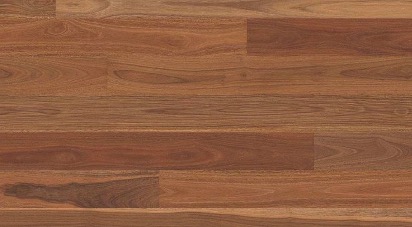
Spotted Gum:
Spotted Gum is a native Australian timber known for its striking appearance and exceptional durability. Its colour varies from pale to dark brown, with characteristic gum veins and a distinctive grain pattern that adds visual interest to any space. Spotted Gum flooring is highly resistant to wear and tear, making it suitable for high-traffic areas such as living rooms and hallways. Its natural resistance to termites and decay makes it an excellent choice for outdoor decking. Additionally, Spotted Gum timber is relatively easy to maintain and can be sanded and refinished to restore its original lustre.
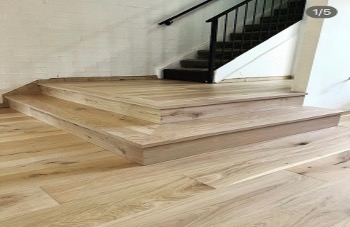
Oak
Oak is a classic choice for timber flooring, prized for its timeless beauty and versatility. European Oak is highly sought after for its warm, golden hues and elegant grain patterns. Oak flooring is available in various finishes, including natural, stained, and distressed, allowing homeowners to achieve various looks to suit their preferences. In addition to its aesthetic appeal, Oak flooring is known for its strength and stability, making it suitable for installation in both residential and commercial settings.
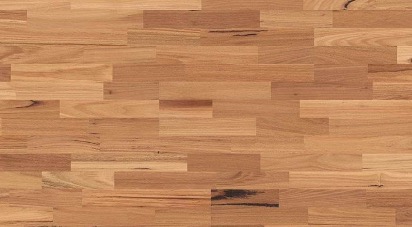
Australian Blackbutt
Australian Blackbutt is another native Australian hardwood favoured for its light colour and subtle grain patterns. Its creamy tones range from pale straw to soft brown, creating a bright and airy feel in any space. Blackbutt flooring is highly durable and resistant to wear, making it suitable for high-traffic areas such as kitchens and dining rooms. Its natural resistance to termite attacks and decay makes it popular for outdoor decking and structural applications. With its warm, inviting appearance and exceptional durability, Australian Blackbutt is a versatile option for contemporary and traditional homes.
Types of Timber
Now for the exciting part, where we discuss different design and style options for your Timber Flooring!
Timber allows for design and style options that are as diverse as they are stunning when it comes to flooring. Below is a list of some of our favourite options.
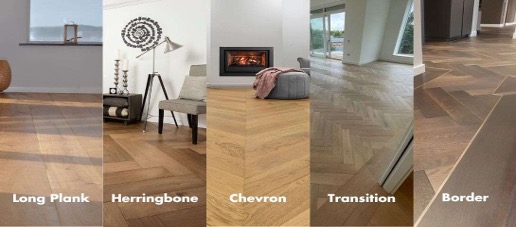
Herringbone
The herringbone pattern is a timeless classic that adds a touch of elegance and sophistication to any space. Characterized by its distinctive V-shaped pattern, herringbone flooring creates visual interest and enhances a room’s aesthetic appeal. This design works particularly well in formal settings, such as living rooms, dining rooms, or entryways, where it can make a bold statement.
Chevron
Chevron flooring features a V-shaped pattern like herringbone but with the ends cut at a 45-degree angle for a more continuous and uniform look. Chevron flooring offers a modern twist on a traditional design, creating a sense of movement and flow that can visually elongate a room. It is ideal for contemporary interiors or spaces with a desired dynamic focal point, such as kitchens, hallways, or home offices.
Long Planks
Long plank flooring features longer and wider boards, creating a sleek and seamless appearance that can visually expand a room’s size. This style of flooring is perfect for open-plan living spaces or rooms with high ceilings, where it can create a sense of continuity and spaciousness. Long plank flooring comes in various wood species and finishes, allowing homeowners to customize their floors to suit their individual tastes and preferences.
Playing with Transitions
Transition flooring incorporates different materials or patterns to create a seamless transition between two distinct areas, such as between rooms or levels of a home. This design technique allows homeowners to delineate separate zones while maintaining a cohesive and harmonious overall look. Transition flooring can take many forms, from subtle changes in wood grain direction to more dramatic shifts in colour or texture, depending on the desired effect.
Border
Border flooring involves using contrasting wood or tile borders to frame the perimeter of a room or highlight specific areas, such as entryways or focal points. This design element adds visual interest and definition to a space, drawing the eye and accentuating architectural features. Border flooring can be customised to suit any style or aesthetic, from traditional to contemporary, and can be as simple or intricate as desired.
Timber Flooring Challenges and Considerations
Once you have finally decided on your type of timber flooring and how to bring it into your home, there are a few things to remember and watch out for.
Timber flooring is one of the longest-lasting options available, and if maintained well, these issues can make your floors last for decades.
High Maintenance: Timber flooring requires regular maintenance to preserve its beauty and longevity. This includes routine cleaning, avoiding harsh chemicals, and promptly addressing any spills or stains to prevent damage.
Shrinkage: Changes in humidity levels can cause timber flooring to shrink or expand, leading to gaps between boards or buckling. Proper acclimation of the wood before installation and maintaining consistent indoor humidity levels can help mitigate this issue.
Resanding: Timber flooring may show signs of wear and tear, such as scratches or surface damage, over time. Resanding involves removing the top layer of wood to reveal a fresh surface, restoring the floor’s appearance and smoothness.
Restaining: Depending on the type of timber, fading and resanding can change the colours of your floors. Restaining is an option to remedy this, but it can also be done if you want to change the pattern or colour. Make sure to choose the right stain and application method to achieve the desired results without compromising the integrity of the wood.
Fading: Prolonged exposure to sunlight can cause timber flooring to fade or discolour over time. Window treatments such as blinds or curtains can help protect floors from UV rays and minimize fading.
Cupping: Excessive moisture or water damage can cause timber flooring boards to cup or warp, resulting in uneven surfaces. Proper subfloor preparation, moisture barriers, and vigilant maintenance can help prevent cupping and ensure the longevity of your floors.
Moisture: Timber flooring is sensitive to moisture and humidity levels, which can lead to swelling, warping, or mould growth if not adequately controlled or cleaned using excessive moisture. To protect your floors, it’s crucial to address any sources of moisture, such as leaks or spills, and maintain a consistent indoor environment.
Installation: Improper installation techniques can lead to issues such as uneven surfaces, gaps between boards, or structural instability. It’s essential to hire a professional ATFA accredited timber floor installer.
Proper Cleaning and Maintenance Techniques for Timber Floors
When cleaning and maintaining your timber floors, it is essential that you use the proper equipment and techniques to avoid damaging your floors and maintain their longevity.
- Sweep or Vacuum Regularly: Dirt, dust, and debris can scratch the surface of timber flooring if left unchecked. Use a soft-bristle broom or vacuum with a hardwood floor attachment to remove dirt and debris regularly.
- Avoid Excess Water: Timber flooring is susceptible to water damage, so avoid using excessive water or soaking the floor during cleaning. Instead, use a damp mop or cloth with a mild cleaning solution specifically formulated for hardwood floors.
- Promptly Clean Spills: Accidental spills should be cleaned promptly to prevent staining or water damage. Blot up spills immediately with a soft, absorbent cloth, and then clean the area with a damp cloth.
- Use Protective Mats or Rugs: Place mats or rugs at entryways and high-traffic areas to trap dirt and prevent shoe scratches. Avoid rubber-backed or non-ventilated mats, as they can trap moisture and damage the floor.
Protect from Furniture: Use furniture pads or felt protectors on the legs of furniture to prevent scratches and dents when moving or rearranging items. Avoid dragging heavy furniture across the floor to prevent damage.
Periodic Maintenance: Depending on the wear and tear, your timber flooring may require periodic maintenance, such as refinishing, resanding, restaining or resealing. Consult with a professional to determine the appropriate timing and method for maintenance based on the condition of your floors.
Avoid Harsh Chemicals: Avoid using harsh cleaning products, ammonia-based cleaners, or wax-based polishes on timber flooring, as they can damage the finish or leave a residue. Instead, opt for pH-neutral cleaners specifically designed for hardwood floors.
Deep Clean: Once every 12 months you can arrange to have a Deep Clean done to your floors. This is performed by professionals with a machine specially designed for this job.
Why Choose Us

Over 40 Years of experience

Only Australian-made products

Responsive with competitive quotes

Best Value for money
Your Dream Timber Flooring Starts Here – Let’s Make It Happen!
✅ 100% Satisfaction Guarantee – We’re not happy unless you are.
✅ Multi-Award-Winning Timber Flooring Specialists – Trusted by homeowners & businesses.
✅ Locally Owned & Operated in the North Shore – Personalised service, no offshore call centres.
✅ Free, No-Obligation Quotes – Get expert advice with no pressure.
